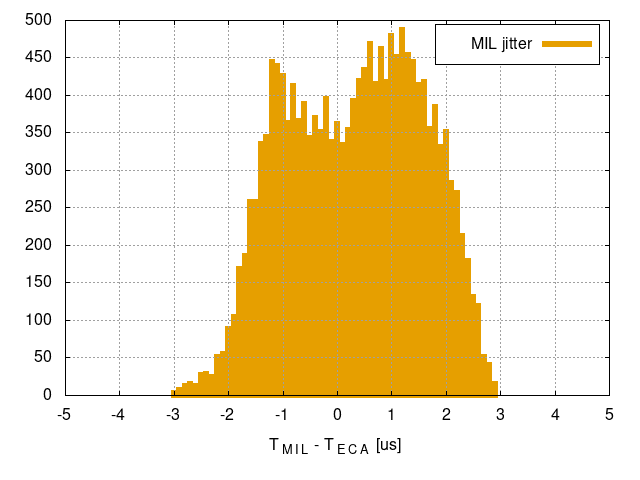You are here: Foswiki>Timing Web>TimingSystemDocumentation>TimingSystemDocuments>TimingSystemWrMil (18 Nov 2024, DietrichBeck)Edit Attach
WR-MIL Gateway
Introduction
The White Rabbit to MIL gateway can work in one GID only. Its main features are.- listen to so-called legacy event numbers, Evtno 0..255
- convert received timing messages to MIL telegrams following a defined mapping
- on-time, send the converted MIL telegrams to the MIL Eventbus
- generate so-called UTC telegrams; this is triggered via a special timing message
- deprecated: if required, generate so-called 'fill events'
- PZU_QR, UNILAC Timing - Source Right
- PZU_QL, UNILAC Timing - Source Left
- PZU_QN, UNILAC Timing - Source High Charge State Injector (HLI)
- PZU_UN, UNILAC Timing - High Charge State Injector (HLI)
- PZU_UH, UNILAC Timing - High Current Injector (HSI)
- PZU_AT, UNILAC Timing - Alvarez Cavities
- PZU_TK, UNILAC Timing - Transfer Line
- SIS18_RING, SIS18 Ring, includes some timing messages for HEST
- ESR_RING, ESR Ring
 Figure: Connections between SCU and converter box.
Figure: Connections between SCU and converter box.
Some remarks
MIL telegrams have 20 bits in total, 16 data bits plus 4 bits for manchester encoding. Bus speed is 1 MHz. Thus sending a MIL telegram takes 20 us. However, MIL protocol has no built-in 'balancing' such as the 8b/10b encoding done with Ethernet. To be on the safe side, it is assumed that a 5us pause is required between MIL telegrams. Thus, it takes 25us for transmitting one MIL telegram. Figure: Typical MIL telegrams have a jitter (max,min) of about 3us.
Figure: Typical MIL telegrams have a jitter (max,min) of about 3us.
Setup
An SCU is used as target platform. To guarantee on-time generation of MIL event telegrams, shared resources (MIL task ram, SCU bus, Wishbone bus, ...) are avoided by using one SCU per MIL event bus (= MIL timing domain).Bugs
During the beamtime 2021, several reports of missing MIL events appeared. For example, the electron cooler in ESR was sometimes not switched off because of a missing event. The reason for the missing events is not found yet. This is a collection of observations related to the missing events. It may help in finding the cause of the probelm.- The WR-event that corresponds to a missing MIL-event is definitely there. The events are not missing in the schedule of the Data Master.
- The conversion of a WR-event into MIL-event happens in an LM32 program. The LM32 sends MIL-events with the correct deadline into the ECA, these events have the ID=0xffffffff0000MMMM, where M represents the bits of the MIL-event. The ECA-WB-Master output channel writes the MIL-event into the MIL-Piggy. By configuring the ECA-IO channel to pulse one of the SCU-IOs at the same event, it can be seen that the firmware indeed injects the event into the ECA. However sometimes the MIL-Piggy doesn't send anything. The Missing Events can be observed on the oscilloscope.
-

- It is unclear why this happens. Speculation: the MIL-Piggy doesn't accept that WB-Write from the EAC-WB-Master output channel for some reason, or the WB-Master output channel has a bug and doesn't execute the WB-write, or the MIL-Piggy accepts the WB-write but has a bug and doesn't send the MIL-Event. => Make a SignalTap that targets the WB-interfaces of ECA-WB-Master output channel and the WB-interface of the MIL-Piggy
- The MIL-Events of the prduction systems (SIS18 and ESR) in BG2.009 have glitches after the last Manchester-bit. This doesn't seem to be a problem because it always happens after the last bit (the parity bit). These glitches do not appear on a similar setup in my office. The reason/source of the glitches is not located yet.
-

- The rate of missing events depends on the schedule, but approximately every 30-60 minutes a MIL event is lost. Often the missing MIL-events are not essential for machine control (e.g. missing UTC timestamp bits). Missing MIL events that are important appear a few times per day.
| I | Attachment | Action | Size | Date | Who | Comment |
|---|---|---|---|---|---|---|
| |
MilJitterHistogram.png | manage | 6 K | 05 Mar 2019 - 15:33 | MichaelReese | Measurement of time differences between MIL events (last falling edge) and an ECA output (rising edge), both triggered by the same timing event |
| |
SIS_18_shutdown_schedule_MIL.txt | manage | 7 K | 20 Sep 2017 - 08:33 | MichaelReese | for the record: a list of MIL events from the SIS18 shutdown schedule as transmitted from the old "Pulszentrale" before the WR-MIL-gateway took over |
| |
mil1.jpg | manage | 288 K | 08 Jun 2021 - 09:32 | MichaelReese | |
| |
missing-mil.jpg | manage | 248 K | 08 Jun 2021 - 09:43 | MichaelReese | |
| |
scu-wr-mil-gw_connection.jpg | manage | 2 MB | 05 Jul 2017 - 12:10 | MichaelReese | |
| |
scu_control.jic | manage | 16 MB | 09 Feb 2018 - 10:44 | MichaelReese | gateware currently running on WR-MIL gateway SCUs |
| |
scu_control.rpd | manage | 16 MB | 09 Feb 2018 - 10:44 | MichaelReese | gateware currently running on WR-MIL gateway SCUs |
| |
scu_control.sof | manage | 5 MB | 09 Feb 2018 - 10:44 | MichaelReese | gateware currently running on WR-MIL gateway SCUs |
| |
wr_mil_jitter_and_latency.png | manage | 89 K | 07 Jul 2017 - 09:54 | MichaelReese |
Edit | Attach | Print version | History: r29 < r28 < r27 < r26 | Backlinks | View wiki text | Edit wiki text | More topic actions
Topic revision: r29 - 18 Nov 2024, DietrichBeck
 Copyright © by the contributing authors. All material on this collaboration platform is the property of the contributing authors.
Copyright © by the contributing authors. All material on this collaboration platform is the property of the contributing authors. Ideas, requests, problems regarding Foswiki? Send feedback


